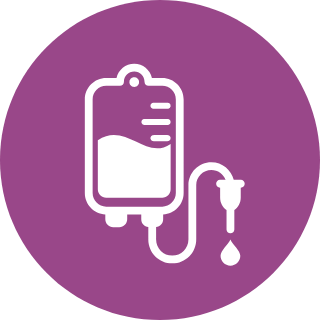
Breast Cancer Treatment Plan
Each patient’s treatment is tailored to:(1)
The specific type of breast cancer diagnosed and the biology of the tumour
The stage of the breast cancer
Overall health, age and other medical conditions
Personal preferences
Breast cancer treatment can be divided into systemic and local therapy.(1)

Systemic Therapy(2)
 Chemotherapy
Chemotherapy  Targeted therapy
Targeted therapy  Hormonal therapy
Hormonal therapy  Immunotherapy
Immunotherapy
Systemic therapies are drugs that spread throughout the body to treat cancer cells wherever they may be. They include chemotherapy, hormonal therapy, targeted drugs, and immunotherapy.
Systemic therapy can also be given before breast cancer surgery — an approach called neoadjuvant therapy — to help shrink the tumour and make it easier to remove surgically.
In both adjuvant and neoadjuvant systemic therapy, the main aim is to kill or control unseen microscopic metastatic growths before they spread. This reduces the risk of distant spread of breast cancer in the years after surgery.Women with metastatic breast cancer may receive various systemic therapies to control the disease.
Chemotherapy(3)
What is Chemotherapy?
Chemotherapy is the use of drugs to destroy cancer cells. Cancer cells grow and divide more quickly than normal cells, and chemotherapy targets these cells that are rapidly growing. However, the drugs used for chemotherapy can still cause damage to healthy cells.
-
Neoadjuvant chemotherapy is chemotherapy given before surgery or radiotherapy to shrink tumours
-
Adjuvant chemotherapy is therapy given after surgery or radiotherapy to destroy any remaining cancer cells

The Goals of Chemotherapy(3)
The goals of chemotherapy depend on the type of cancer and how far it has spread. Sometimes, the goal of treatment is to get rid of all the cancer and keep it from coming back. If this is not possible, chemotherapy can be used to delay or slow cancer growth instead – a form of therapy sometimes called palliative chemotherapy.
Chemotherapy Treatment Plan(3)
One’s combination of chemotherapy drugs will depend on factors such as:
The type and stage of cancer
The tumour size and location
One’s age and general health
How well one can cope with certain side effects
Concomittant medical conditions
Previous cancer treatments
Targeted Therapy
What is Targeted Therapy?
Targeted therapy is the use of drugs or other substances to precisely target and attack certain types of cancer cells. This form of therapy can be used on its own or in combination with other treatments.(4)
How is targeted therapy different from chemotherapy?
Targeted therapy drugs, like other drugs used to treat cancer, are a form of anti-cancer therapy. Targeted therapy drugs work differently from traditional chemotherapy drugs in two key ways:
-
Because of their targeted action, these drugs have a strong effect on cancer cells, and mostly leave normal, healthy cells alone. On the other hand, traditional chemotherapy is cytotoxic to most cells, meaning it can damage normal, healthy cells in addition to damaging and killing cancer cells.
-
Targeted drugs often work by blocking cancer cells from copying themselves. This means they can help stop a cancer cell from dividing and making new cancer cells. Traditional chemotherapy, however, only kills cancer cells that have already been made.

How Targeted Therapy Works(4)
Targeted therapy uses drugs designed to target cancer cells without affecting normal cells. Targeted therapy drugs find and attack specific areas in cancer cells, or detect and block signals that make cancer cells grow. They can also signal the cancer cells to destroy themselves. However, not all cancer cells will react the same way to the targeted therapy drugs.(4)
Targeted Therapy Treatment Plan(5)
One’s combination of targeted treatment drugs will depend on factors such as:
The type and stage of cancer
The tumour size and location
One’s age and general health
How well one can cope with certain side effects
Any other medical conditions
Previous cancer treatments
Most patients will have to combine targeted therapy with other forms of treatment such as surgery, chemotherapy, radiotherapy, or hormonal therapy.
Hormonal Therapy
What is Hormonal Therapy?
Some breast cancers grow under the influence of hormones. Hormonal therapy uses drugs to lower hormone levels or block the actions of hormone receptors in order to help slow or stop the growth of cancer cells.(6)
How Hormonal Therapy Works
Different types of hormone therapy work in different ways. They can:(7)
-
Stop the body from making the hormone
-
Block the hormone from attaching to cancer cells
-
Alter the hormone so it doesn’t work like it should

The Goal of Hormonal Therapy
Hormonal therapy is often used sequentially after chemotherapy but can be used in combination with targeted therapy and also radiation therapy. It can also minimise symptoms related to breast cancer.(8)
Immunotherapy
What is Immunotherapy?
Immunotherapy is a type of cancer treatment that helps and boost your immune system to fight cancer. The immune system helps your body fight infections and other diseases like cancer. Immunotherapy uses the power of the body’s own immune system to control, prevent and eliminate cancer.(9)
How does Immunotherapy work against cancer?
As part of its normal function, the immune system is precise as it is able to detect and destroy abnormal cells and their main objective is to detect and stop the growth of cancer cells while sparing healthy cells. For example, immune cells are sometimes found in and around tumors. These cells, called tumor-infiltrating lymphocytes or TILs, are a sign that the immune system is responding to the tumor. People whose tumors contain TILs often do better than people whose tumors don’t contain them.(9)
Even though the immune system can prevent or slow cancer growth, cancer cells have ways to avoid destruction by the immune system. For example, cancer cells may:(9)
Have genetic changes that allows them to hide from the immune system
Expresses proteins on their surface that turn off immune cells through interaction.
Change the normal cells around the tumor so they interfere and disrupt with how the immune system responds to the cancer cells.
Immunotherapy helps the immune system to better act against cancer.(9)
Local Therapy
 Surgery
Surgery  Radiotherapy
Radiotherapy
Local therapy removes the cancer from a limited area, such as the breast, chest wall and/or lymph nodes in the underarm area. It also helps prevent the cancer from coming back to that specific area.(10)
The treatment plan for those who opt for local therapy may include surgery, with or without radiation therapy, to the breast and nearby lymph nodes.(10)
Surgery
Many women with breast cancer have some form of surgery as part of their treatment in order to remove the tumour and other affected areas, such as lymph nodes.(11)
The main types of surgery to remove breast cancer are:(11)

Breast Conserving Surgery (BCS)
Wide excision / Lumpectomy
Hookwire localisation
Oncoplastic breast conserving surgery
Periareolar Incision
Vertical Scar Incision
Wise Pattern Incision
Mastectomy
Simple mastectomy
Abdomen Flap (DIEP or TRAM)
Latissimus Dorsi (LD) Flap from Back
Axillary Surgery
Sentinel Lymph Node Biopsy (SLNB)
Axillary Clearance
Radiotherapy
What is Radiotherapy?
Radiotherapy is a cancer treatment that uses high doses of radiation to kill cancer cells and shrink tumours. However, this process does not happen immediately and may take several weeks of treatment.(12)
How does Radiotherapy Work?(12)
There are two main types of radiation therapy:
External Beam Radiation Therapy uses a machine to aim radiation specifically at the cancer.
Internal Radiation Therapy is a local treatment in which a source of radiation is used to treat a specific part of the body.

The Goals of Radiotherapy
Radiotherapy is commonly used alongside other cancer treatments to improve the chances of the treatment working.(12)
Radiotherapy Plan
When radiation is combined with surgery, it can be given:(12)
Before surgery, with the aim of shrinking the size of the cancer so it can be removed by surgery and be less likely to return.
During surgery, to target the cancer directly without passing through the skin. Radiation therapy used this way is called intraoperative radiation. With this technique, doctors can more easily protect normal tissues nearby from radiation.
After surgery, with the aim of killing any cancer cells that remain.
The type of radiation therapy that one may need depend on many factors, including:(12)
The type and stage of cancer
The size and location of the tumour
The proximity of one’s tumour to other tissues that are sensitive to radiation
One’s general health and medical history
Whether one will have other types of cancer treatment
Other factors, such as one’s age and other medical conditions
Palliative Care
What is Palliative Care?
Palliative care is care given to improve the quality of life of patients who have a serious or life-threatening disease, such as cancer. Palliative care is an approach to care that addresses the person as a whole, not just their disease. The goal is to prevent or treat, as early as possible, the symptoms and side effects of the disease and its treatment, in addition to any related psychological, social, and spiritual problems. Palliative care is also called comfort care, supportive care, and symptom management. Patients may receive palliative care in the hospital, an outpatient clinic, a long-term care facility, or at home under the direction of a physician.(13)
When is palliative care used in cancer care?
Palliative care may be provided at any point along the cancer care continuum, from diagnosis to the end of life. When a person receives palliative care, he or she may continue to receive cancer treatment.(14)
References:
(1) Susan G Komen Organisation. Treatment Options – Breast Cancer Diagnosis. 2021. Available at https://www.komen.org/breast-cancer/treatment/by-diagnosis [Accessed May 2021]
(2) Memorial Sloan Kettering Cancer Center. Systemic Therapy for Breast Cancer. 2021. Available at: https://www.mskcc.org/cancer-care/types/breast/treatment/systemic-therapy [Accessed on May 2021]
(3) Cancer.Net. Understanding Chemotherapy. American Society of Clinical Oncology. 2019. Available at: https://www.cancer.net/navigating-cancer-care/how-cancer-treated/chemotherapy/understanding-chemotherapy [Accessed on May 2021]
(4) American Cancer Society. How Targeted Therapies Are Used to Treat Cancer. 2021. Available at: https://www.cancer.org/treatment/treatments-and-side-effects/treatment-types/targeted-therapy/what-is.html [Accessed on May 2021]
(5) Cancer Council Victoria. Targeted therapy. 2018. Available at https://www.cancervic.org.au/cancer-information/treatments/treatments-types/targeted-therapy [Accessed on May 2021]
(6) Canadian Cancer Society. Hormonal therapy for breast cancer. 2021. Available at: https://www.cancer.ca/en/cancer-information/cancer-type/breast/treatment/hormonal-therapy/?region=ns [Accessed May 2021]
(7) American Cancer Society. Hormone Therapy. 2020. Available at: https://www.cancer.org/treatment/treatments-and-side-effects/treatment-types/hormone-therapy.html [Accessed May 2021]
(8) Yale Medicine. Hormonal Therapy for Cancer. 2021. Available at: https://www.yalemedicine.org/conditions/cancer-hormone-therapy [Accessed May 2021]
(9) National Cancer Institute. Immunotherapy to Treat Cancer. National Institutes of Health. 2019. Available at https://www.cancer.gov/about-cancer/treatment/types/immunotherapy#how-does-immunotherapy-work-against-cancer [Accessed May 2021]
(10) Susan G Komen Organisation. Treatment by Breast Cancer Diagnosis. 2021. Available at: https://www.komen.org/breast-cancer/treatment/by-diagnosis [Accessed on May 2021]
(11) SingHealth Group. Breast Cancer – Diagnosis to Treatment. 2019. Available at: https://www.singhealth.com.sg/patient-care/conditions-treatments/breast-cancer-diagnosis-treatment [Accessed April 2021]
(12) National Cancer Institute. Radiation Therapy to Treat Cancer. National Institutes of Health. 2019. Available at: https://www.cancer.gov/about-cancer/treatment/types/radiation-therapy [Accessed May 2021]
(13) DocDoc. (n.d.). Transforming healthcare, empowering lives. DocDoc. Retreived October 14, 2021, Available at https://www.docdoc.com/medical-information/procedures/palliative-care
(14) National Cancer Institute. Palliative Care in Cancer. National Institutes of Health. 2017. Available at https://www.cancer.gov/about-cancer/advanced-cancer/care-choices/palliative-care-fact-sheet [Accessed June 2021]